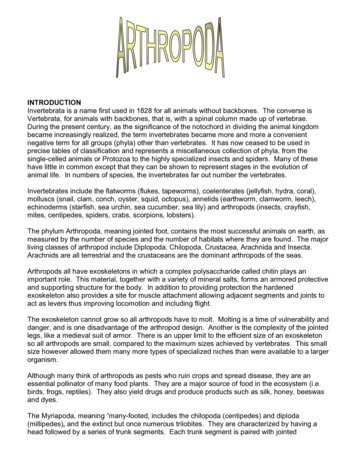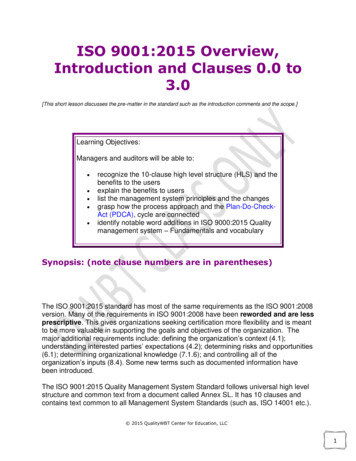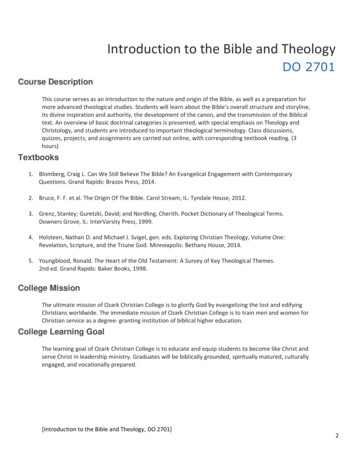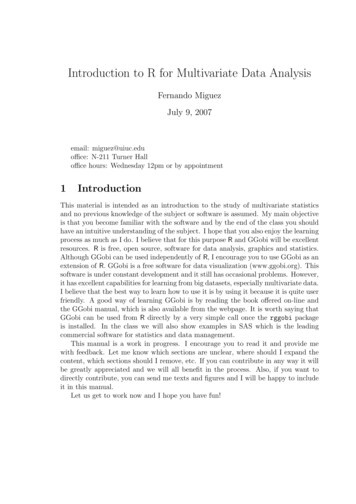
Transcription
INTRODUCTIONInvertebrata is a name first used in 1828 for all animals without backbones. The converse isVertebrata, for animals with backbones, that is, with a spinal column made up of vertebrae.During the present century, as the significance of the notochord in dividing the animal kingdombecame increasingly realized, the term invertebrates became more and more a convenientnegative term for all groups (phyla) other than vertebrates. It has now ceased to be used inprecise tables of classification and represents a miscellaneous collection of phyla, from thesingle-celled animals or Protozoa to the highly specialized insects and spiders. Many of thesehave little in common except that they can be shown to represent stages in the evolution ofanimal life. In numbers of species, the invertebrates far out number the vertebrates.Invertebrates include the flatworms (flukes, tapeworms), coelenterates (jellyfish, hydra, coral),molluscs (snail, clam, conch, oyster, squid, octopus), annelids (earthworm, clamworm, leech),echinoderms (starfish, sea urchin, sea cucumber, sea lily) and arthropods (insects, crayfish,mites, centipedes, spiders, crabs, scorpions, lobsters).The phylum Arthropoda, meaning jointed foot, contains the most successful animals on earth, asmeasured by the number of species and the number of habitats where they are found. The majorliving classes of arthropod include Diplopoda, Chilopoda, Crustacea, Arachnida and Insecta.Arachnids are all terrestrial and the crustaceans are the dominant arthropods of the seas.Arthropods all have exoskeletons in which a complex polysaccharide called chitin plays animportant role. This material, together with a variety of mineral salts, forms an armored protectiveand supporting structure for the body. In addition to providing protection the hardenedexoskeleton also provides a site for muscle attachment allowing adjacent segments and joints toact as levers thus improving locomotion and including flight.The exoskeleton cannot grow so all arthropods have to molt. Molting is a time of vulnerability anddanger, and is one disadvantage of the arthropod design. Another is the complexity of the jointedlegs, like a medieval suit of armor. There is an upper limit to the efficient size of an exoskeletonso all arthropods are small, compared to the maximum sizes achieved by vertebrates. This smallsize however allowed them many more types of specialized niches than were available to a largerorganism.Although many think of arthropods as pests who ruin crops and spread disease, they are anessential pollinator of many food plants. They are a major source of food in the ecosystem (i.e.birds, frogs, reptiles). They also yield drugs and produce products such as silk, honey, beeswaxand dyes.The Myriapoda, meaning “many-footed, includes the chilopoda (centipedes) and diploda(millipedes), and the extinct but once numerous trilobites. They are characterized by having ahead followed by a series of trunk segments. Each trunk segment is paired with jointed
appendages. The centipedes are somewhat flattened and are agile carnivores with one pair ofjointed legs associated with each trunk segment. The millipedes are not as active as centipedesand have two pairs of legs with each trunk segment. The millipedes may roll into a ball forprotection and are herbivorous.Crustaceans are predominantly marine organisms but can also be found in freshwater lakes andrivers. There are also a few terrestrial species. They are the only arthropod to have two pairs ofantennae. They also have two pairs of mandibles (jaws).In greek the word arachne means “spider”. Arachnids were among the first arthropods to moveonto land. The scorpion being one of the most ancient of extant arachnids. The arachnids alsoinclude whip scorpions, daddy longlegs, mites, ticks, and several minor orders with the mostsuccessful and diverse group of arachnids being the spiders.Arachnids are characterized by having two major body regions (cephalothorax and abdomen),eight legs and instead of true jaws they have chewing appendages called chelicerae. Theabdomen contains the reproductive and respiratory organs. Arachnids do not have true antennaebut their first appendages, called pedipalps, may be used like antennae in some types. Mostarachnids are predacious and typically feed by releasing digestive enzymes over or into their preyand then sucking the predigested liquid.Among spider’s adaptations are the spinning glands. All spiders produce protein strands (silk)and ½ of all spider species spin silk into webs. Spider silk is 5X stronger than steel of the samediameter and is very light. A strand of silk reaching around the earth would weight 1 lb. Silk isalso used for nest lining, sperm webs or egg sacs, wrapping prey among others.The largest arthropod class Insecta is characterized for their three major body regions and sixlegs with a pair of antennae, and a pair of mandibles. The type of mouthparts that an insectpossesses determines how it feeds. Insects usually have two pair of wings and are the onlyinvertebrate that can fly.Insects dominate the land. Recent estimates suggest there may be from fifteen to thirty millioninsect species. Most people in our culture dislike insects. Perhaps, insects are pests only fromthe human point of view! Humans and insects are both trying to find food, build homes, andsurvive. But occasionally, we come into competition with each other for these resources, orbecome resources ourselves.An entomologist (one who studies insects) tries to look at life from the insects’ point of view andtries to discover the role insects play in the natural world. This is, indeed, an enormous task, forthere is no other animal group on earth that is as diverse in the number of species, as abundantin the number of individuals, and as successful in occupying almost every conceivable niche.Insects comprise over 90% of all animal species on earth. Today, there are over 1 millionspecies of insect named and scientists are estimating the discovery of another 5-30 millionspecies. The vast majority of these insects are extremely valuable to the natural world andhuman society. It is estimated that only 1% are considered to be pests.2
WHAT IS AN ARTHROPOD?jointed, paired appendageshard exoskeletonbilateral symmetrybody divided into distinct regionsTHE FIVE MAJOR LIVING CLASSES OF THE PHYLUM ARTHROPODA ARE:ARACHNIDA (spiders, scorpions, mites, ticks, whip scorpions, solpugids) 4 pairs of legs 1 or 2 body regions (cephalothorax, abdomen) No wings No antennae Mostly terrestrial, some freshwater 35,000 speciesCRUSTACEA (crayfish, crabs, shrimp, barnacles, sowbugs, copepods) 5 or more pairs of legs 2 body regions (cephalothorax, abdomen) No wings 2 pairs of antennae, usually Mostly marine, some freshwater, a few terrestrial 35,000 speciesDIPLOPODA (millipedes) 2 pairs of legs on most body segments Cylindrical, multi-segmented body No wings 1 pair of antennae Terrestrial 8,000 speciesCHILOPODA (centipedes) 1 pair of legs on most body segments Flattened, multi-segmented body No wings 1 pair of antennae Terrestrial 5,000 speciesINSECTA (beetles, butterflies, wasps, grasshoppers, flies, termites,dragonflies, etc.) 3 pairs of legs 3 body regions (head, thorax, abdomen) 1 or 2 pairs of wings (sometimes absent) 1 pair of antennae Mostly terrestrial or fresh water, a few marine 1-30 million species3
The Animal Kingdom: Where Insects Fit InKingdom:AnimaliaPhylum:PROTOZOA – single celled animalsPORIFERA – spongesCOELENTERATA – jellyfish, hydroids, corals, sea anemonesPLATYHELMINTHES – flatwormsNEMATHELMINTHES – roundwormsTROCHELMINTHES – rotifersBRACHIOPODA – brachiopodsBRYOZOA – moss animalsMOLLUSCA – mollusks (e.g. clams, snail, octopi)ECHINODERMATA – starfish, sea urchins, crinoids, sea cucumbersANNELIDA – earthworms, leeches, marine wormsONYCHOPHORA – onychophora (e.g. Peripatus)ARTHROPODA – insects, arachnids, crustaceans, millipedes, centipedesCHORDATA – fishes, amphibians, reptiles, birds, mammalsPhylum:ARTHROPODA INSECTS AND THEIR RELATIVES5 Major Living ClassesSubphylum:TRILOBITAClass:Trilobites – extinct, known from fossils onlySubphylum:CHELICERATAClass:Arachnida – spiders, scorpions, mites, ticks, etc.Xiphosura – horseshoe crabsPyncnogonida – sea spidersEurypterida – extinct, fossils onlySubphylum:MANDIBULATAClass:Crustacea – crabs, shrimps, sowbugs, copepods, barnacles, amphipodsDiplopoda – millipedesChilopoda – centipedesPauropoda – pauropodsSymphyla – similar to centipedesInsecta – beetles, butterflies, wasps, flies, termites, grasshoppers, etc.There are 30 major orders of the class INSECTA: (10 main in BOLD)Protura – proturansDermaptera – earwigsHomoptera – cicadas, planthoppers, aphidsCollembola – springtailsIsoptera – termitesNeuroptera – lacewings, antlionsDiplura – dipluransEmbioptera – webspinnersColeoptera – beetlesThysanura – bristletails, silverfishPlecoptera – stonefliesStrepsiptera – twisted-wing parasitesEphemeroptera – mayfliesZoraptera – sorapteransMecoptera – scorpionfliesOdonata – dragonflies, damselfliesPsocoptera – psocidsTrichoptera – caddisfliesOrthoptera – grasshoppers,Mallophaga – chewing liceLepidoptera – butterflies, mothskatydidsMantodea – mantidsAnoplura – sucking liceDiptera – fliesBlattodea – cockroachesThysanoptera – thripsSiphonoptera – fleasPhasmatodea – walkingsticksHemiptera – true bugsHymenoptera – ants, wasps, bees4
HOW OLD ARE anDevonianMILLIONS OF YEARS500 - 550430 - 500395 - 430345 – 395Carboniferous280 – 345PermianTriassic225 – 280190 – nePliocenePleistocene135 – 19065 – 13554 – 6538 – 5426 – 387 – 261.5 – 715 TY – 1.5MESOZOICCENOZOICDESCRIPTIONfirst Arthropodsfirst vertebrates (Ostracoderms)first land animals (scorpions & millipedes)first insects, amphibiansAge of Fishesfirst winged insects (flight!) large insects,primitive reptilesmodern orders of insectsAge of Reptiles, first mammals, firstflowering plantsfirst birds (Archeopteryx)Age of Mammals and Flowering Plantsfirst man(TY thousand years)Why are insects so important?1. Pollination – Over 80% of the world’s flowering plants are pollinated by insects such asbees, flies, beetles, moths, ants, wasps, butterflies, and thrips. Without these insects,plants could not reproduce or bear fruit. Flower shape, color, nectar, and scent haveevolved to attract their insect pollinators. (See the Insect Zoo’s honeybee exhibit for a listof plants.)2. Decomposition – Insects speed up this process immensely, thereby helping to unlocknutrients and return them back to the earth. Termites help break down dead trees; carrionbeetles break down carcasses and help control disease; others eat decaying leaves, fungi,etc.3. Role in the food web – Insects and other arthropods are the main food of many differentkinds of animals (song birds, shore birds, birds of prey, fish, lizards, reptiles, shrews,moles, rodents, bats, tamarins, numbats, bushbabies, etc., etc., etc.). In addition, insectsthemselves are major predators of other insects.4. Biological control agents – Much research is being directed at using insects as naturalcontrol agents for insect pests, weeds, and waste products such as dung.5. Ecological monitors – By making baseline studies of insect diversity and population size inan ecosystem, changes can be spotted quickly and early. Insects are small and have ashort life cycle so respond immediately to toxins in their environment while vertebratesusually suffer cumulative effects over long periods of time.6. Aeration of the soil – Consider the actions of burrowing beetles, crickets, larvae, andbillions of ants!5
7. Medical research – Insects are responsible for one of the first antibiotics, for the anestheticchloroform (a form of formic acid which is produced by ants), anti-tumor hormones andothers. The insect world holds many more important secrets.8. Other research – Genetics, physiology, bio-control, pheromones, hormones, etc.9. Insect products – Silk, honey, beeswax, shellac, dyes, manna, to name a few!10. Aesthetics – Butterflies are some of the most beautiful creatures on earth; many beetleshave been sought and collected for centuries for jewelry, and figure prominently inEgyptian and Asian art.11. Economic impact on our agricultural and forestry industry – Crop damage, the attemptederadication of insect pests caused the indiscriminant overuse of DDT, a broad-spectrumpesticide.12. Medical impact – A few insects are vectors of some serious diseases (malaria, yellowfever, encephalitis) or can cause severe allergic reactions.13. Protectors of our wild lands from human invasion – For many centuries, the mosquitoes,biting flies, and other inhospitable insects keep “civilized” man from encroaching on ourrainforests.Why are insects so successful?Arthropods have lived on earth for over 500 million years. They were the first to overcome theproblems of terrestrial living such as: respiration, dehydration, locomotion and food. Below arethe major features contributing to their success.1. Exoskeleton: a hard armor that supports and protects2. Wings: for dispersal, escape, and mobility3. Small size: for niche exploitation, escape4. High reproductive capability: their short life cycle and capacity for laying millions of eggsallows rapid adaptive changes through genetic flexibility and mutation.5. Metamorphosis: reduces competition between the immature and adult, allows forspecialization for feeding and reproduction. Larval forms often adapted for living in a nichethat is different from the adult’s resulting in less competition within a species.6. Adaptations for survival: protective coloration (mimicry, camouflage, eye spots, warningcoloration, etc.), spines, urticating (itchy) hairs, modification of the ovipositor into a stinger,defensive odors, defensive secretions, etc.6
EXTERNAL ANATOMY OF INSECTSExoskeletonInsects do not have an internal skeleton to support their body like vertebrates do. Instead, theyhave a hardened exoskeleton (outer skeleton) for support. This unique structure serves fourmain functions:1. Support for the body.2. Protection: The exoskeleton is made up of chitin, which is very hard and insoluble inwater, alcohol, dilute acid and alkali, and the digestive enzymes of animals.3. Site for muscle attachment: The exoskeleton provides a large site for muscle attachmentgiving insects incredible strength (a honey bee can lift 300 times its body weight).4. Resistance to water loss: The exoskeleton has a waxy coating, which makes itimpermeable to water. This reduces water loss through the “skin” or body wall. Thisfeature enables insects to live in arid areas as well as aquatic environments.The exoskeleton is best developed in beetles (perhaps explaining why beetles are such a large,successful, and highly diversified group) and least developed in insects that live in protectedsituations (i.e., termites) or ones that have other means of protection.While a wonderful feat of engineering, the exoskeleton has some negative aspects, too. SeeInsect Growth.7
Three Body PartsThe insect body is divided into three main body parts: the head, the thorax, and the abdomen.Each part is specialized to perform different tasks and has specific appendages (i.e., antennae,legs, ovipositors) and structures to help perform these tasks. Insect appendages are jointed toallow flexibility.1. HEAD: primarily an information and food gathering structure.a. Eyes: most insects have a pair of compound eyes and three simple eyes. Sightplays a very important role in most insects’ lives. (See Vision section below.)b. Antennae: primarily organs of smell, taste, feel, and communication.c. Mouthparts: food-gathering structures. There are several kinds of mouthparts ininsects. The structure of the mouthparts gives clues to the diet of an insect. Someexamples of different kinds of mouthparts are: 8Chewing: grasshoppers, dragonflies, beetles, termitesChewing-sucking: beesPiercing-sucking: true bugs, some flies, fleas, liceSucking (lapping, sponging, siphoning): some flies, butterflies
2. THORAX: primarily involved with locomotiona. Wings: used for locomotion, dispersal, escape, food search, visual display andoccasionally sound production.Most insects have two pairs of wings except for flies, which have one pair. Thewings are absent in some of the more primitive insects or ones that have lost themsecondarily.Wings vary in size, shape, venation, and appearance (membranous, scaly,hardened, hairy). These traits are used in identifying characteristics.b. Legs: used for locomotion, dispersal, escape, grasping, digging, and occasionallysound production. Insect legs come in many styles: jumping, swimming, running,burrowing, grasping, etc.3. ABDOMEN: contains the digestive and reproductive organsa. External genitalia: ovipositor, claspers, cercib. Respiratory structures: spiracles or air holes, some aquatic larvae have gills9
ColorationThe color of an insect may be due to pigment in the body wall or to the structure of theexoskeleton (seen only under electron microscope). The scales on butterfly wings cause thislight bending which is responsible for their beautiful colors.In most insects, pigment is deposited within a few hours after the molt. Some, like dragonflies,may require a week or more. Pigment production is usually genetically controlled, but may beaffected by environmental conditions. Some pigments are synthesized by the insect while othersare obtained from food.Coloration is more developed, generally, in insects with less developed exoskeletons.Coloration is important in species identification, sexual identification, courtship, and defense(camouflage, mimicry, warning coloration, eye spots, etc.).INSECT GROWTHMoltingThe exoskeleton has its limitations, too. Because of its hardness and rigidity, it has no ability toexpand and grow once formed. To accommodate for this, insects and other arthropods must moltor shed their exoskeleton periodically. As a result, insects grow in spurts. During the moltingprocess, an insect is very vulnerable to attack, damage, and dessication.Hormones produced in the brain play a role in molting. The technical term for molting is ecdysis.The hormone, which controls molting is called ecdysone.MetamorphosisThe periodic molting of the exoskeleton made possible the evolution of metamorphosis in insects.Metamorphosis is a change in form during the growth process. Hormones produced in the braincontrol this process, too (i.e., juvenile hormone).The ability to metamorphose has several advantages.1. Each life stage is specialized, which increases efficiency and success. For example, thelarval stage is specialized as an eating machine. Its exoskeleton is softer so that it cangrow a bit; the adult stage is specialized for reproduction and dispersal.2. Competition for food and habitat resources within a species and within a population isreduced because the larva and adult often have different food habits and occupy differentniches. In addition, there is often a seasonal separation of the adult and immature lifestages also resulting in reduced competition.3. With the aid of metamorphosis, insects, even with their small size, have the ability towithstand climatic extremes (cold, drought). Most insects can over-winter in an egg orpupal stage, which affords them protection from the climate and enables them to survivelong periods when food is scarce.10
There are two major types of metamorphosis: complete and incomplete.1.Complete Metamorphosis:Egg .larva . .pupa adultSome insects with complete metamorphosis are: beetles, flies, bees, and butterflies.2.Incomplete Metamorphosis:Egg .nymph adultSome insects with incomplete metamorphosis are: crickets, true bugs, cockroaches, and termites.Sexual DeterminationIn most insects, the egg and the sperm are haploid (one chromosome of each pair). Each eggcontains an “X” chromosome; ½ of the sperm contain an “X” chromosome, the other ½ lack an“X” chromosome. So, the sex of an insect is determined at fertilization. The male has just one “X” chromosome XO The female has two “X” chromosomes XXBees are a little different. The males are haploid and develop from unfertilized eggs while thefemales are diploid and develop from fertilized eggs.Life SpanInsects, by comparison with vertebrates, have very short life spans. In general, insects hatchfrom eggs in the spring, grow and live through the spring and summer, reproduce in the summerand fall, lay eggs (which overwinter), and then die. However, in the insect world there are infinitevariations on this theme. Some beetles like the darkling beetle live for 10 to 15 years. TheMonarch butterfly overwinters as an adult. Some flies live for only 24 hours.11
INTERNAL ANATOMY AND PHYSIOLOGYReproductionIn insects, like in most vertebrates, the sexes are separate, and reproduction is sexual. However,parthenogenesis occurs in some species (i.e., walkingsticks). In some social insects, the adultworkers are unable to reproduce because their sexual organs are undeveloped.Like the vertebrate, the female has ovaries and the male has testes, which are located in theabdomen. All insects produce eggs. Eggs may be laid singly or in batches via the ovipositor ofthe female. In some species, the eggs are enclosed in an egg case (mantids, roaches).The male testes produce sperm, which in primitive orders, are encased in spermatophores.These are transferred to the female during copulation, or placed on a substrate and taken up bythe female. The female has a sack-like structure called the spermatheca, in which sperm arestored after copulation. Females also have glands which secrete an adhesive material used tofasten the eggs to some object or to produce a protective covering for an egg mass.Courtship in insects varies greatly, and is discussed briefly under Insect Senses. See also thespecific fact sheets for detailed descriptions.Nervous SystemInsects have a central nervous system like the vertebrates. It consists of a brain located in thehead, ganglia, and a ventral nerve cord. Generally, the brain is larger in insects with complexsocial behavior.RespirationInsects breathe oxygen as we do. Respiration is achieved through a network of tracheal tubesand spiracles (openings in the exoskeleton). These tubes extend through the body by branchinginto all tissues. Oxygen entering through the spiracles is directly transmitted to the tissues via thebranching tracheae.An open tracheal system with open spiracles occurs in most insects. Closed tracheal systemswith permanently closed spiracles occur in some aquatic and some parasitic insects. Someaquatic insects have tracheal gills (dragonfly nymphs), or carry an air bubble trapped on hairs, ortrapped somewhere on the body.12
CirculationThe circulatory system transports salts, hormones, and products of digestion to the organs andtissues of the insect. Insects have an open circulatory system as opposed to the closed systemin vertebrates. The only blood vessel is the long tube dorsal to the digestive tract. Everywhereelse the blood flows through the body cavity.The heart is a series of chambers divided by valves. Circulation is achieved by pulsation of theheart. The blood is pumped forward and then moves back through the body cavity. Most organsand tissues are exposed to and bathed by circulatory blood.The blood is usually a clear fluid in which hemocytes (cells) are suspended. It is often greenishor yellowish, but seldom red.DigestionInsects feed upon almost every organic substance found in nature and their digestive systemsreflect that variety. The digestive system is complete and consists of a hollow tube that extendsthe full length of the body. The tube is made up of: a mouth, pharynx, esophagus, crop,proventriculus (foregut, midgut, hindgut), and anus.Labial glands near the mouth (like salivary glands) secrete juices that aid in digestion. The labialglands in the larvae of butterflies and moths secrete silk, which is used in making cocoons.Fat bodies serve as food storage reservoirs enabling some insects to go for long periods withouteating.ExcretionThe excretory system consists of a set of malpighian tubules. Waste products are taken up fromthe blood by these tubules and passed out by way of the hindgut and anus. Glands in the rectumremove water and slats from the waste material (feces). The word for insect waste material isfrass.MusclesThe muscles of insects are very strong and efficient. Most insects can lift up to 20X their bodyweight due to the efficient supply of oxygen by the tracheal system and the leverage created bythe large area of muscle attachment. Insect muscles are capable of very rapid contraction. Wingbeats of up to a few hundred per second are common, and up to 1,000 beats per second occur,too.13
GlandsInsects have salivary glands, hair glands, scent glands, wax glands, adhesive glands, silk glands,and many others. These glands vary in function and location on the body from species tospecies. All spiders produce protein strands (silk) and 1/2 of all spider species spin silk intowebs. Spider silk is 5x stronger than steel of same diameter and very light. A strand of silkreaching around the earth would weigh 1 lb.INSECT SENSESHearingInsects produce sounds to: Attract and locate matesAggregate their species to a mating site, food source, or social groupingDefend or warnDistinguish members of the same speciesDefine their territorySome examples of insects that produce sounds are: true bugs, crickets, grasshoppers, katydids,beetles, cicadas, butterflies, wasps, etc.Sound is usually produced by rubbing two parts of the body together, one part having a file, theother part having a ridge. Producing sound in this way is called stridulating. It can be twowings, a wing and a leg, or any other two parts of the body. Insects can also produce sounds bytapping or vibrating some part of their body or by forcing air through their spiracles (hissingcockroaches).Insects detect sounds by hair sensilla or tympanal organs (sensory cells attached to membranes).Some tympanal organis are found on the abdomen (cicada, moths, grasshoppers) while othersare found on the leg. Mosquitos hear with hairs on their antennae (Johnston’s organ).Rhythm, not pitch, is the important component in recognition.TouchInsects are extremely sensitive to touch and vibrations. The touch receptors are hair sensilla orseta, which are connected to nerve cells. These hairs are abundant on the antennae but alsooccur practically everywhere on the insect’s body.VisionVision varies a great deal within the insect world, from excellent in butterflies, to poor in termites.But in general, vision is a very important sense in insects. They use their eyes to find food,mates, homes, oviposition sites, to detect predators, etc. Because of this, we owe the widevariety of colors in flowering plants to the insect. The flower has evolved to attract its primarypollinator, the insect.The optic lobes of insects are the most highly developed areas of the brain. The eyes of wingedinsects are superior to ours at detecting motion. A bee’s photoreceptors are about the same sizeas ours. The number of neurons devoted to visual points in a fly far exceeds the number ofhuman visual connections. The spectrum of colors seen by insects is wider than our own. It14
ranges from ultra-violet to near infra-red in the case of some butterflies (the human spectrum islimited to violet through red).A new theory is that although the visual range is limited to objects that are fairly close by humanstandards, within that range, some insects can distinguish fine detail.The lens system of the insect eye is known as the compound eye. The compound eye seesimages. The lens is divided into separate facets. The number of facets varies from species tospecies. The dragonfly, a great hunter, leads with 28,000. In contrast, the underground workerant has only nine (9). Generally, the acuity of the eye reflects the lifestyle and needs of theinsect. Imagine the fine detail of a flower or twig that escapes our own eyes!In addition, some insects have simple eyes that are limited to discrimination of movement, light,perhaps color, and possibly, have navigational functions.There are both diurnal and nocturnal forms of the compound eye and they differ in how theygather light. Hair-like structures on the eyes function as anti-glare devices.Bioluminescence is the production of light by a living thing. Some click beetles, firefly beetles,and a few flies produce light for various reasons. The larvae of a fungus gnat, which occurs incaves produce light to attract small insects which they eat. Lightning bugs use it to attract matesand some insects use it to confuse prey and allow them to be caught.Smell and Taste (Chemo-reception)Insects do not have taste buds, but do have chemical receptors for testing. Taste is detected bycontact with receptors located on the antennae (bees, ants) and some on the legs (flies,butterflies). In essence, flies taste with their feet!Smell is detected through air. Insects differ in their sensitivity to various smells during differentperiods of time. Chemo-reception is a very important and interesting aspect of interest life. Smellis used to: Identify members of the same species or hiveFind and attract members of the opposite sexFind foodFind proper hosts on which to lay eggsDetermine directionThe insect’s keen sense of smell has been used in trapping systems that are baited with speciesspecific pheromonesOther SensesInsects also have thermal and humidity receptors.15
FEDERAL REGISTER OF ENDANGERED & THREATENEDSPECIES OF ARTHROPODSCRUSTACEANSCommon NameHay’s Spring amphipodCalifornia freshwater shrimpZophonastes crayfishNashville crayfishShasta crayfishMadison Cave isopodSocorro isopodAlabama cave shrimpSquirrel Chimney shrimpLee County cav
echinoderms (starfish, sea urchin, sea cucumber, sea lily) and arthropods (insects, crayfish, mites, centipedes, spiders, crabs, scorpions, lobsters). The phylum Arthropoda, meaning jointed foot, contains the most successful animals on earth, as measured by the number of species and the number of habitats where they are found. The major










